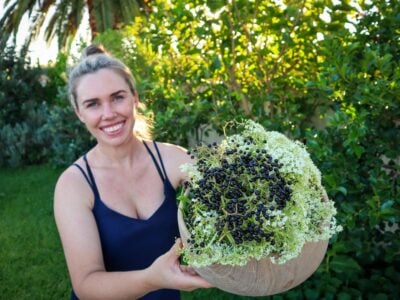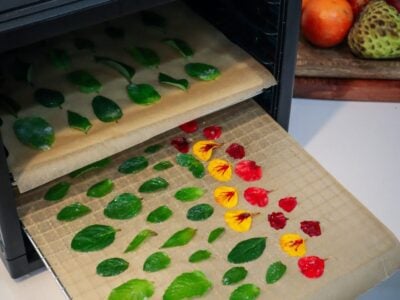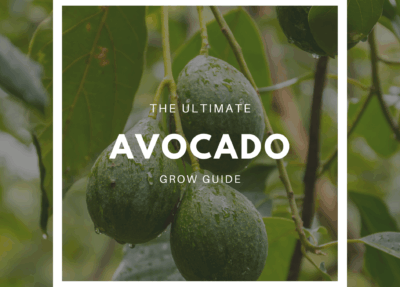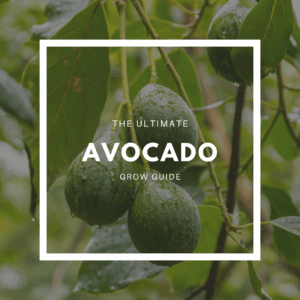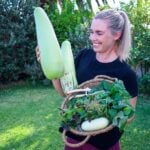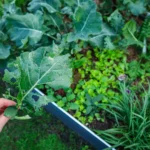Impact-Site-Verification: 25510a47-3242-44a7-9676-7c9c1e441b89
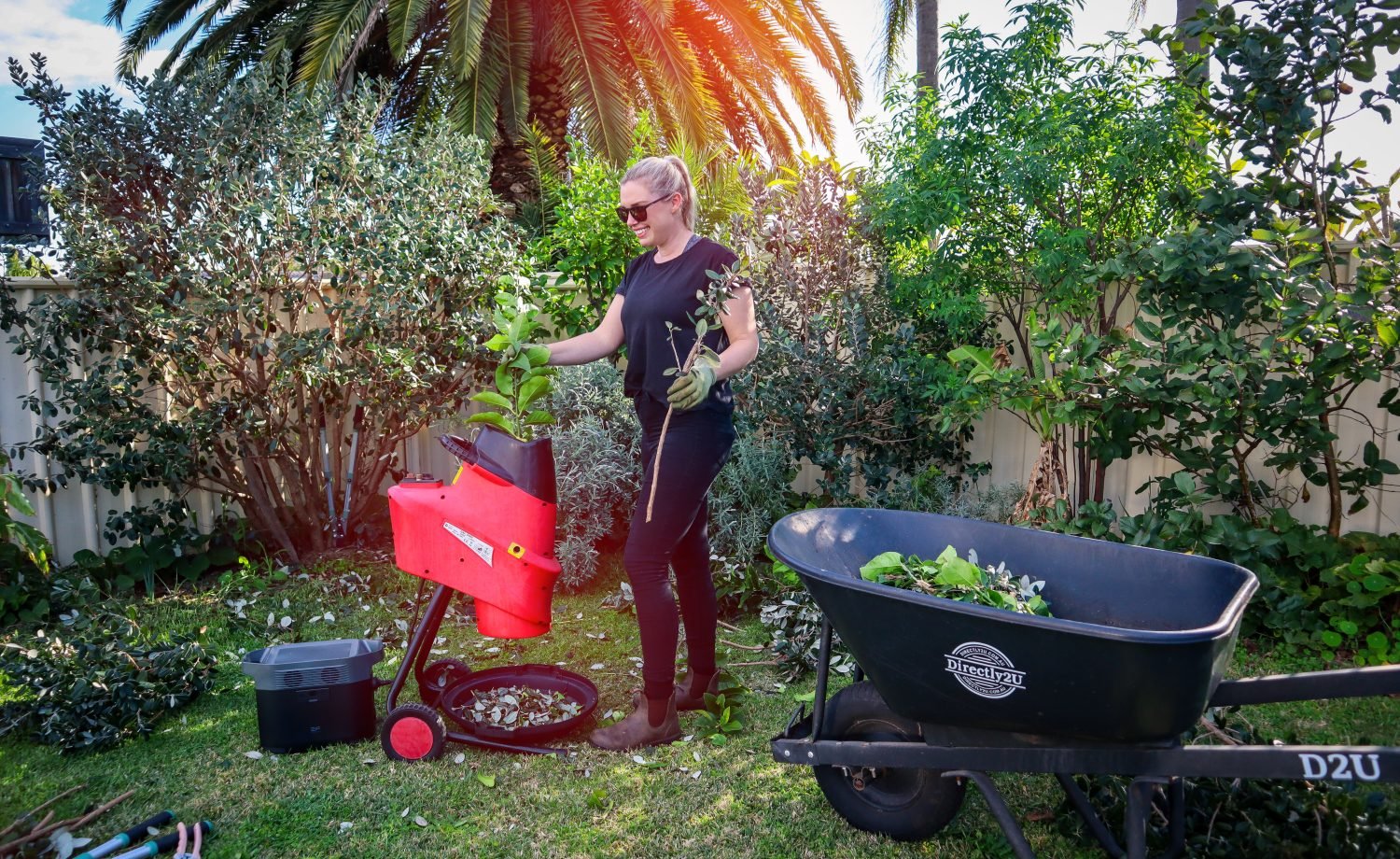
What Edible Plants to Grow for Mulch and Improve Sandy Soil
Gardening in sandy soil can be a challenge, especially in hot, dry climates. Sandy soil drains quickly, lacks nutrients, and struggles to retain moisture. However, by choosing the right plants, you can naturally improve soil health while also growing food. In this post, I’ll share five of the best plants to grow for mulch and improve sandy soil, all of which are fast-growing, drought-tolerant, and multi-functional. These plants help build organic matter, retain moisture, and create a thriving ecosystem in your garden.
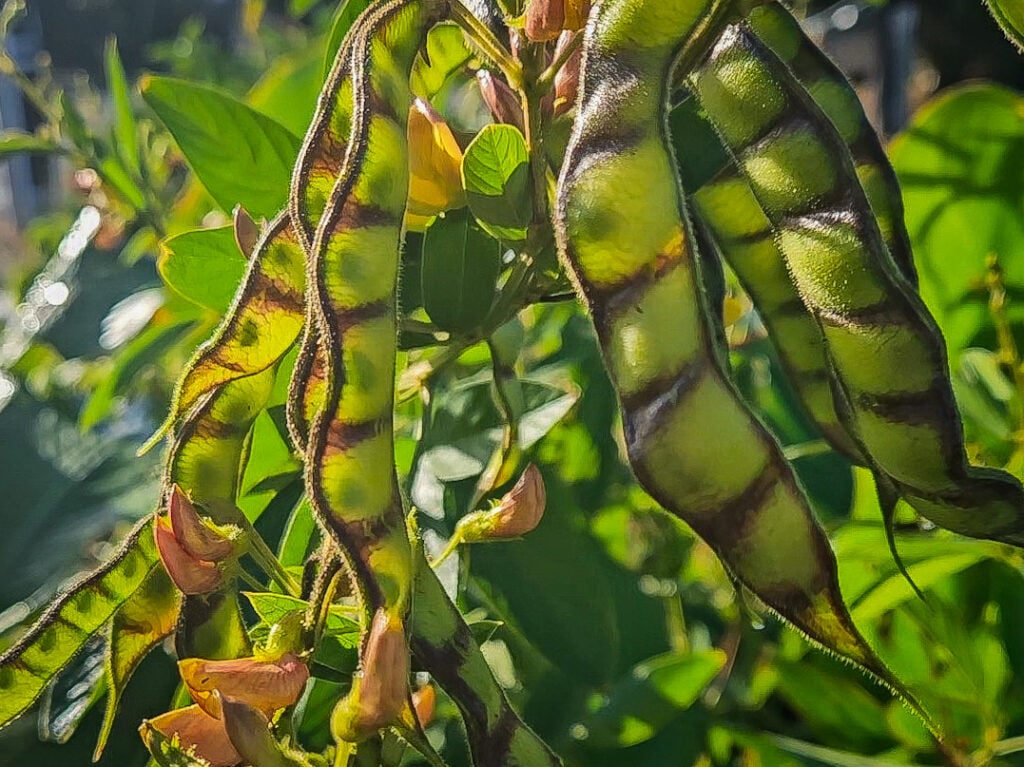


Pigeon Pea (Cajanus cajan)
Pigeon pea is a nitrogen-fixing shrub that grows quickly and thrives in poor soil conditions. This makes it an excellent pioneer plant for mulching to improve sandy soil and support other plants in your garden.
Benefits of Pigeon Pea:
- Fixes nitrogen, enriching the soil naturally
- Produces edible, protein-rich peas
- Attracts pollinators and beneficial insects
- Provides dappled shade for smaller plants
- Offers abundant biomass for mulch and soil improvement
- Works as a windbreak and shelter for small birds and insects
Pigeon pea is a short-lived perennial (4-5 years) and can be used to establish a garden while building soil fertility.
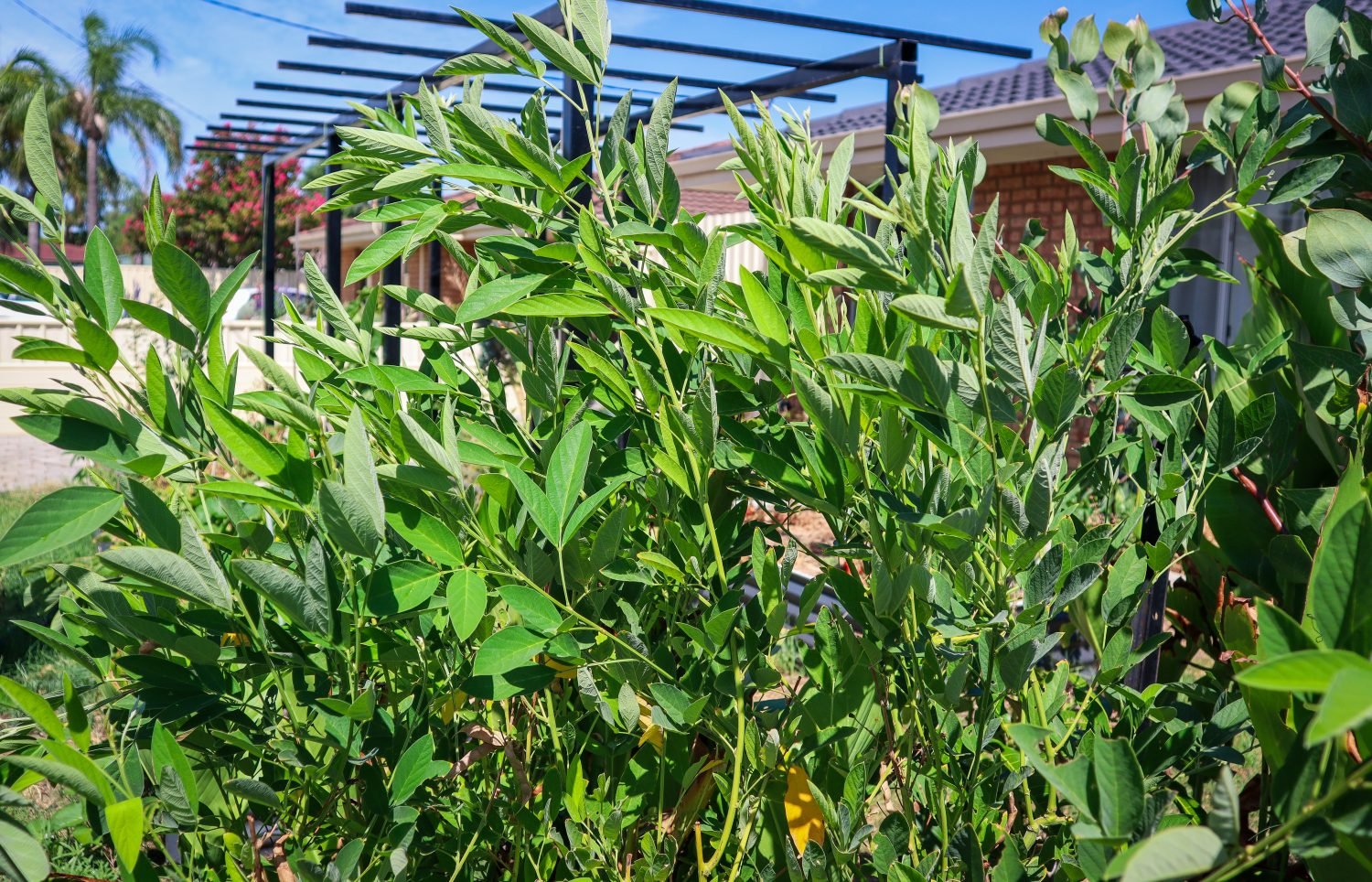

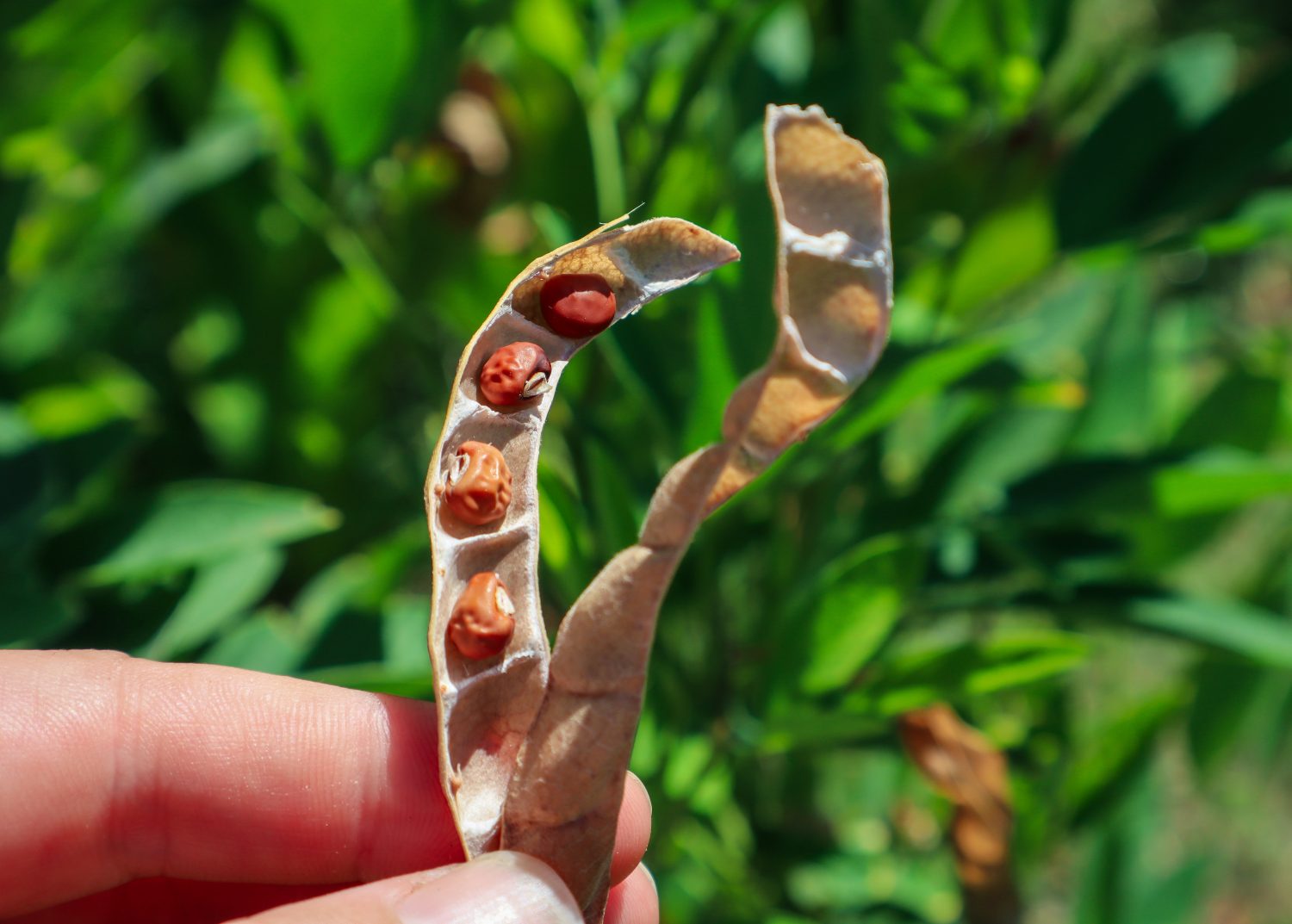
Edible Canna (Canna edulis)
Edible canna is a fast-growing, low-maintenance plant that produces starchy, edible rhizomes and large leaves perfect for mulching.
Benefits of Edible Canna:
- Edible tubers can be eaten raw, cooked, or made into crispy chips or flour
- Young shoots can be eaten as a nutritious green vegetable
- Dense growth provides wind protection and shade
- Attracts pollinators with its red flowers
- Grows well in poor soil with little water
- Chop-and-drop plant for organic mulch
- Helps stabilize soil and prevent erosion
Edible canna is ideal for hot, dry climates and will quickly improve the organic matter and moisture retention of sandy soil.
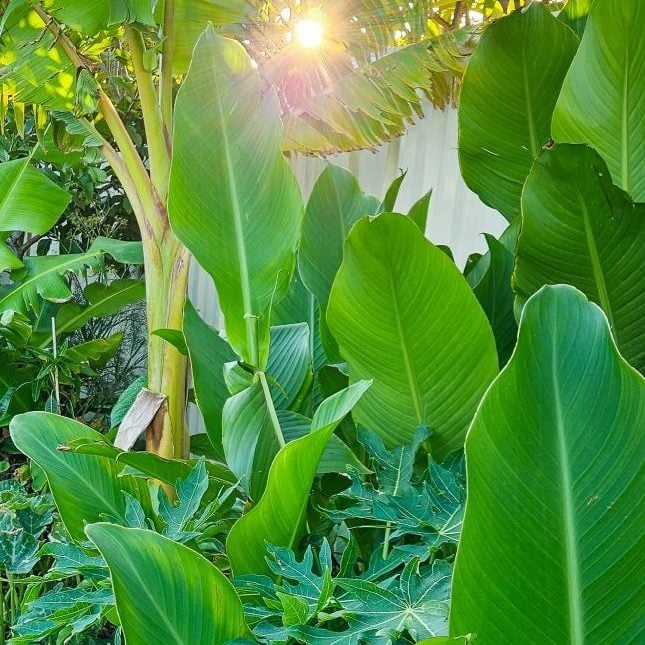


Banana (Musa spp.)
Bananas are one of the best plants for improving sandy soil and creating a moist, nutrient-rich microclimate.
Benefits of Bananas:
- Fast-growing with large leaves that provide valuable shade
- Produces nutrient-rich mulch when chopped and dropped
- Helps retain moisture in sandy soil
- Improves soil structure by breaking down organic matter quickly
- Provides delicious fruit for home gardens
Bananas are heavy feeders, so they benefit from compost, manure, or worm castings. Plant them in groups to create a thriving, moisture-rich ecosystem.
Feijoa (Acca sellowiana)
Feijoa, also known as pineapple guava, is a hardy shrub that thrives in drought-prone and sandy soil conditions.
Benefits of Feijoa:
- Tolerates drought and poor soil
- Produces delicious, fragrant fruit
- Provides dense foliage for wind protection
- Low-maintenance and easy to grow
- Can be used as a hedging plant to protect other crops
Feijoa is an excellent addition to sandy-soil gardens, offering both food and improved soil structure. They grow so much each year, which provides a consistent supply of green material to mulch. This is currently my top producer for mulch in the garden, and I use a mini mulcher with the Ecoflow battery pack to give me cordless solar power anywhere in the garden.
Cassava (Manihot esculenta)
Cassava is a tough, resilient root crop that thrives in hot, dry climates and nutrient-poor soil.
Benefits of Cassava:
- Grows well in sandy, well-draining soil
- Produces large, starchy tubers that can be boiled, fried, or made into flour
- Fast-growing, reaching 2-3m tall in one season
- Drought-tolerant once established
- Leaves are edible when cooked
- Chop-and-drop plant for mulch and soil improvement
- Helps prevent soil erosion with its strong root system
Cassava is an excellent survival crop that helps build soil health and provides a reliable food source.
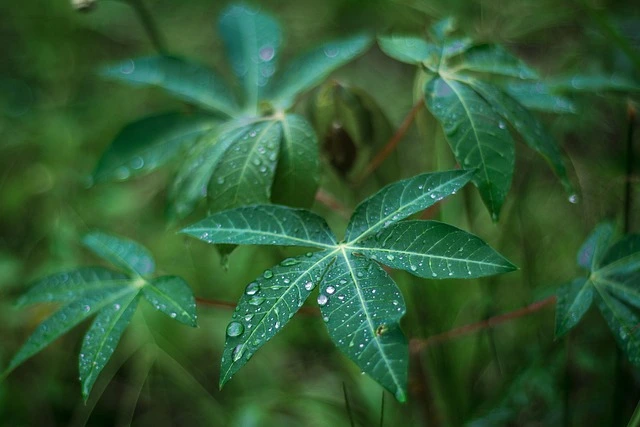
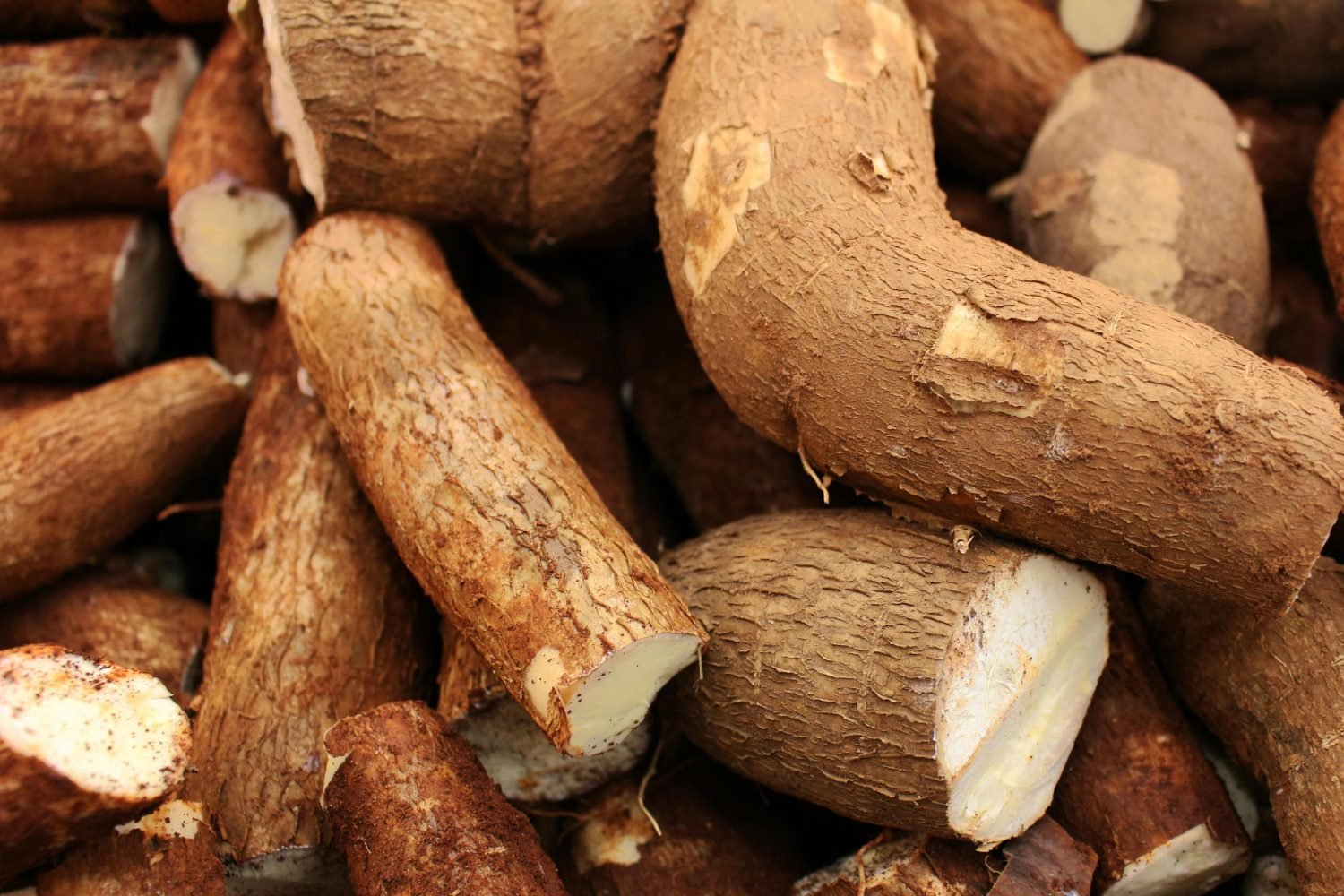
Mulching for the win!
If you’re gardening in sandy soil, these five plants to grow for mulch will help improve organic matter, retain moisture, and build long-term soil fertility. By growing multi-functional, fast-growing plants, you can create a thriving, resilient garden—even in harsh conditions.
Never Lose Power Again! ⚡ My Go-To Solar Battery Pack for Gardening
Watch the full video for more info on mulching
Don’t forget to like and subscribe for more gardening tips! 🌱
Links included in this description might be affiliate links. If you purchase a product or service with the links that I provide I may receive a small commission. There is no additional charge to you! Thank you for supporting my blog so that I can continue to provide you with free content.
Are you growing any of these plants? Let me know in the comments! And if you found this helpful, share it with fellow gardeners.
Happy gardening!
Holly 🌿
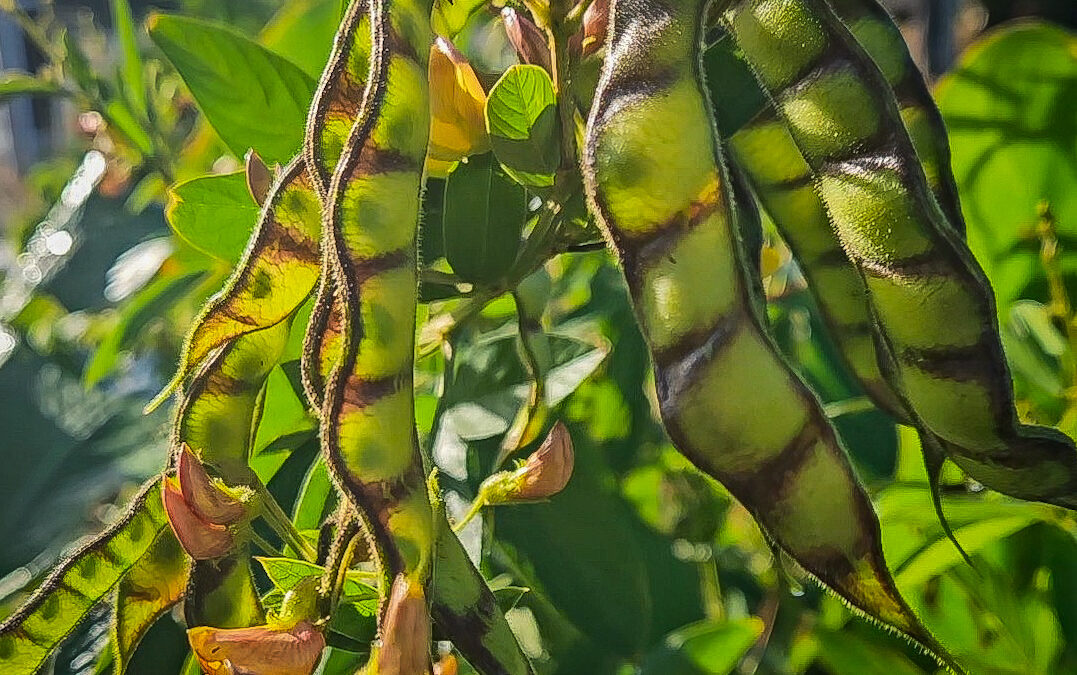
Pigeon Pea : A Versatile Permaculture Powerhouse
Pigeon pea (Cajanus cajan) is a fast-growing, nitrogen-fixing shrub that thrives in poor soil conditions while providing multiple benefits to the garden. Whether you’re looking for a hardy pioneer plant, a nutritious food source, or an effective soil builder, pigeon pea is a must-have in any sustainable garden or food forest.
Are you struggling with poor sandy soil and crispy plants from not enough summer shade? Then keep reading because this easy-to-grow edible plant could be the answer!
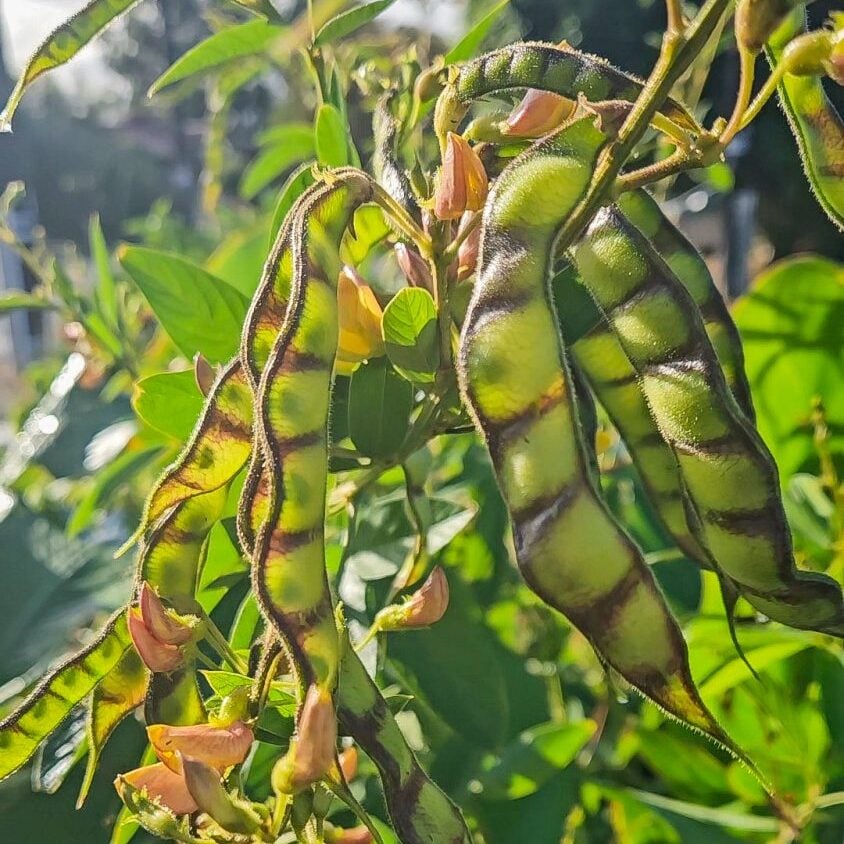
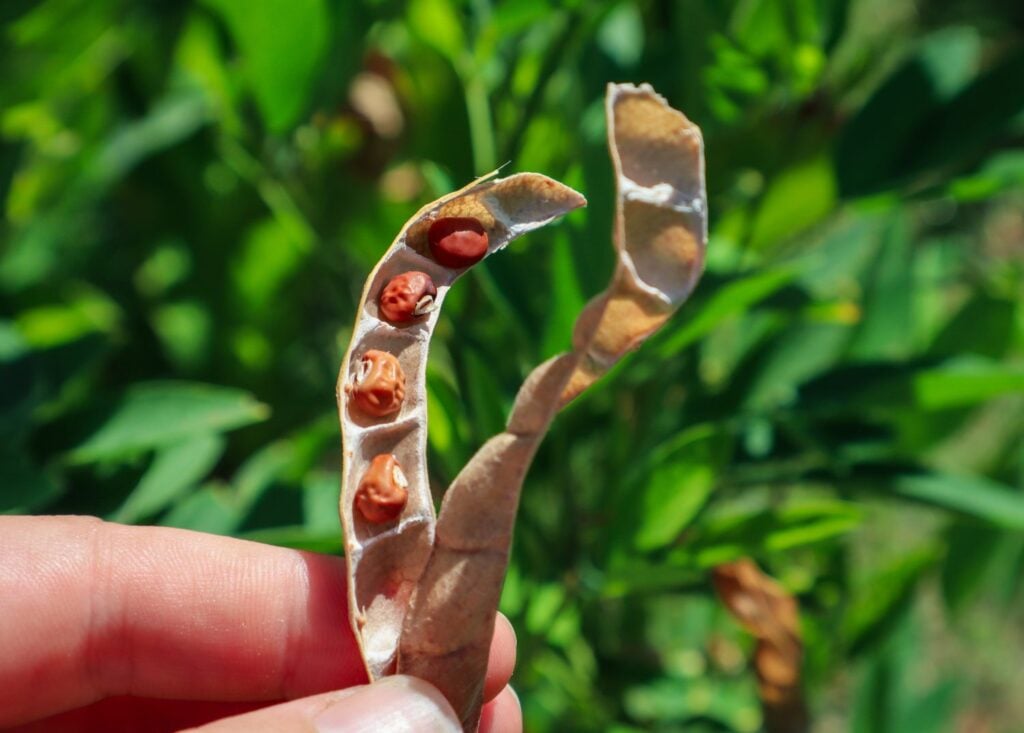
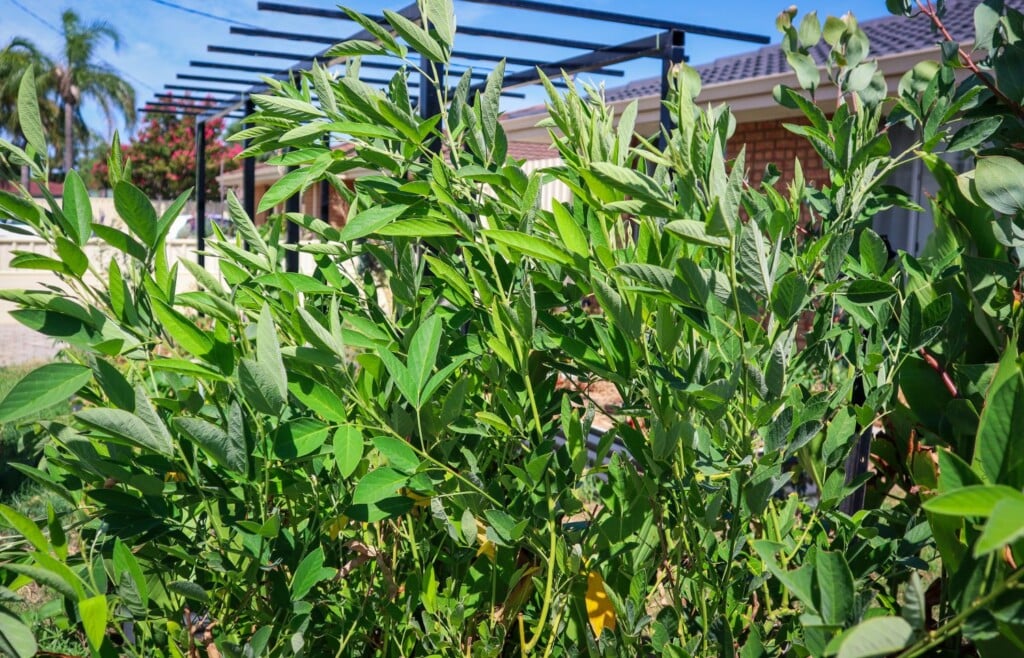
Benefits of Growing Pigeon Pea in a Permaculture Garden
1. Pigeon Pea Improves Soil Health
Pigeon pea is an excellent nitrogen fixer, meaning it naturally enriches the soil by pulling nitrogen from the air and making it available to other plants. This is especially valuable in poor, sandy soils where organic matter is often lacking. Additionally, its deep taproot helps break up compacted soil, improving aeration and water retention. It is a great plant to grow in newly established gardens where soil quality is low.
2. Creates Dappled Shade
This shrub grows quickly and provides light, dappled shade that protects lower-growing plants from harsh sun exposure. This makes it an excellent companion plant for young fruit trees and vegetable crops that benefit from reduced heat stress.
3. Attracts Beneficial Insects & Pollinators
The bright yellow flowers of pigeon pea are highly attractive to bees, butterflies, and other beneficial insects. These pollinators help increase biodiversity in your garden and improve the yield of surrounding fruiting plants.
4. Nutritious & Versatile Edible Crop
Pigeon peas are a rich source of protein, carbohydrates, and fiber, making them a valuable addition to a self-sufficient diet. They can be eaten in various ways:
- Fresh in salads
- Steamed like edamame
- Cooked in stews and curries
- Made into burger patties
- Dried and stored for long-term use
Not only are pigeon peas beneficial for human consumption, but they also make excellent high-protein animal feed.
5. Provides Abundant Biomass & Mulch
Pigeon pea produces a significant amount of organic material that can be cut back and used as mulch. This helps retain soil moisture, suppress weeds, and build healthy soil over time. Regular pruning encourages new growth and keeps the plant productive.
6. Windbreak & Habitat for Wildlife
This shrub can be grown as a hedge to provide wind protection for more delicate plants. It also creates shelter for small birds and insects, enhancing the overall ecosystem of your garden.
7. Pioneer Plant for New Gardens
Pigeon pea is an ideal “pioneer” species for establishing new gardens. This means it helps pave the way for establishing more valuable long-term crops. It offers:
- Fast-growing shade
- Nutrient-rich mulch
- Green material for composting
- Pollinator attraction
- Wind protection
- Thrives in poor soil
- Drought tolerant
It is a short-lived perennial, typically lasting 4-5 years, making it perfect for supporting other plants in the early stages of a food forest or permaculture system. As your garden grows and your main fruit tree crops start to get established you can prune back and remove the Pigeon Pea to make room. With so much seed available you will be able to re-grow more plants in other areas of the garden.


How to Grow Pigeon Pea
Pigeon Pea Planting & Soil Requirements
- Thrives in well-draining soil, including poor, sandy soil
- Pigeon Pea prefers full sun but can grow in semi-shade positions
- Drought-tolerant once established
- Grows well from seed planted directly in the ground
- Doesn’t like frosts, but can be grown as an annual crop in cooler climates
- Doesn’t like wet feet as this can cause the roots to rot. Plant on mounded soil to help improve drainage in wet areas.
Maintenance & Care
- Minimal care is required once established
- Benefits from regular pruning to encourage bushy growth and biomass production. It also helps with the ease of harvesting peas at a more manageable height.
- Pigeon Pea can be interplanted with fruit trees, vegetables, or other nitrogen-demanding plants
Harvesting & Usage
- Harvest fresh peas when pods are still green
- Leave pods to dry on the plant for long-term storage of dried peas
- Regular pruning ensures continuous production and plant health
Pigeon Pea Permaculture
This pioneer plant is an invaluable addition to any permaculture garden, offering multiple benefits such as soil improvement, food production, pollinator support, and natural wind protection. Whether you’re starting a new garden or enhancing an existing one, this resilient shrub will help create a thriving, self-sustaining ecosystem.
Start growing Pigeon Pea today and enjoy its many rewards in your sustainable garden!
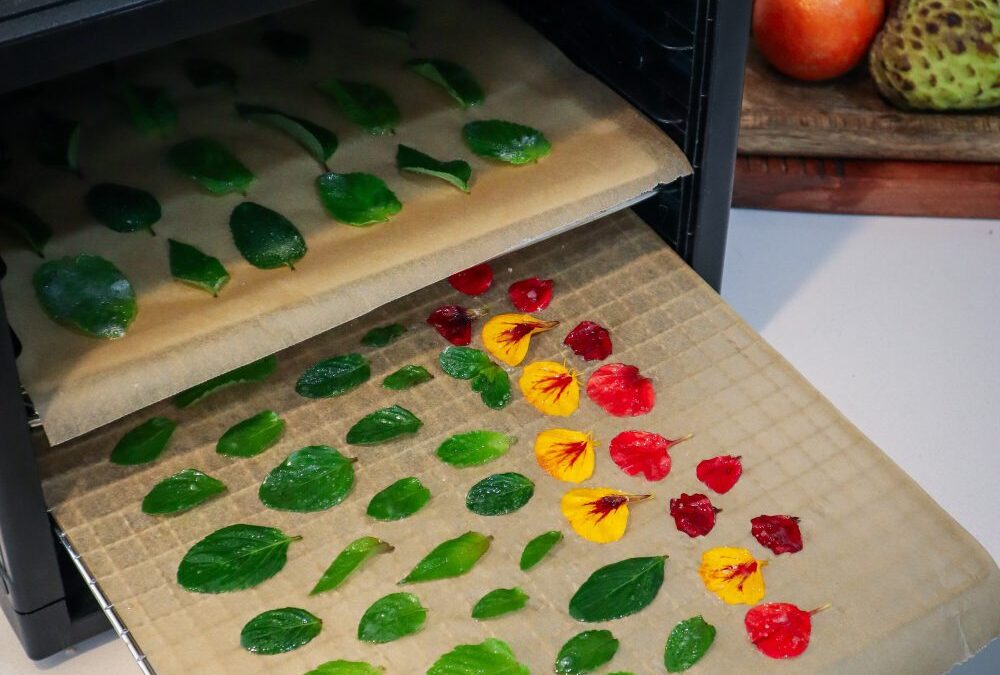
Candied Mint leaves
Add a little bit of flair to your desserts, baked treats, or cocktails with these sparkly, sweet candied mint leaves. They’re beautiful, easy to make, and add a delicate crunch with a refreshing minty finish. Perfect for when you want something a little special to top a cake, tart, pavlova, or even a fancy iced drink.
Mint on its own can sometimes be a little overpowering, but candying softens that intense bite while preserving all the aromatic freshness. The sugar balances the strength of the mint, leaving you with a light, sweet leaf that melts in your mouth and looks stunning as a garnish.
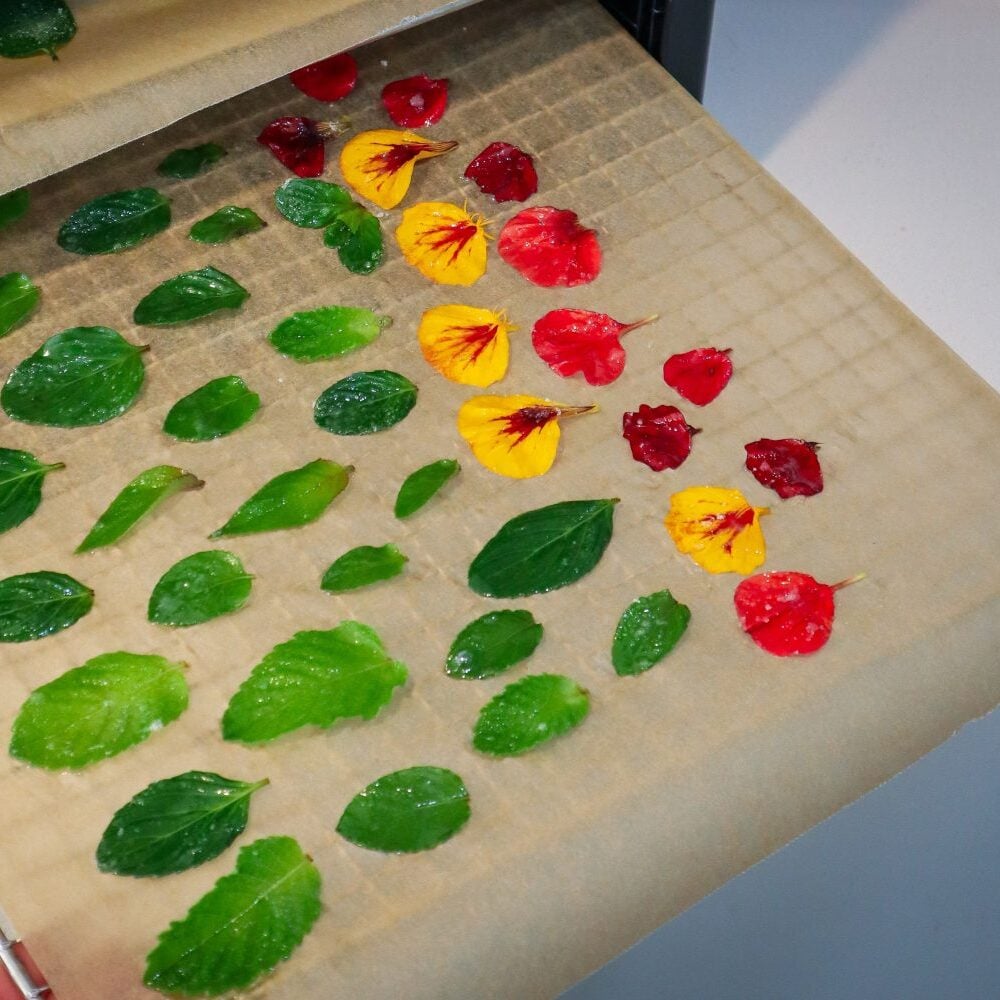

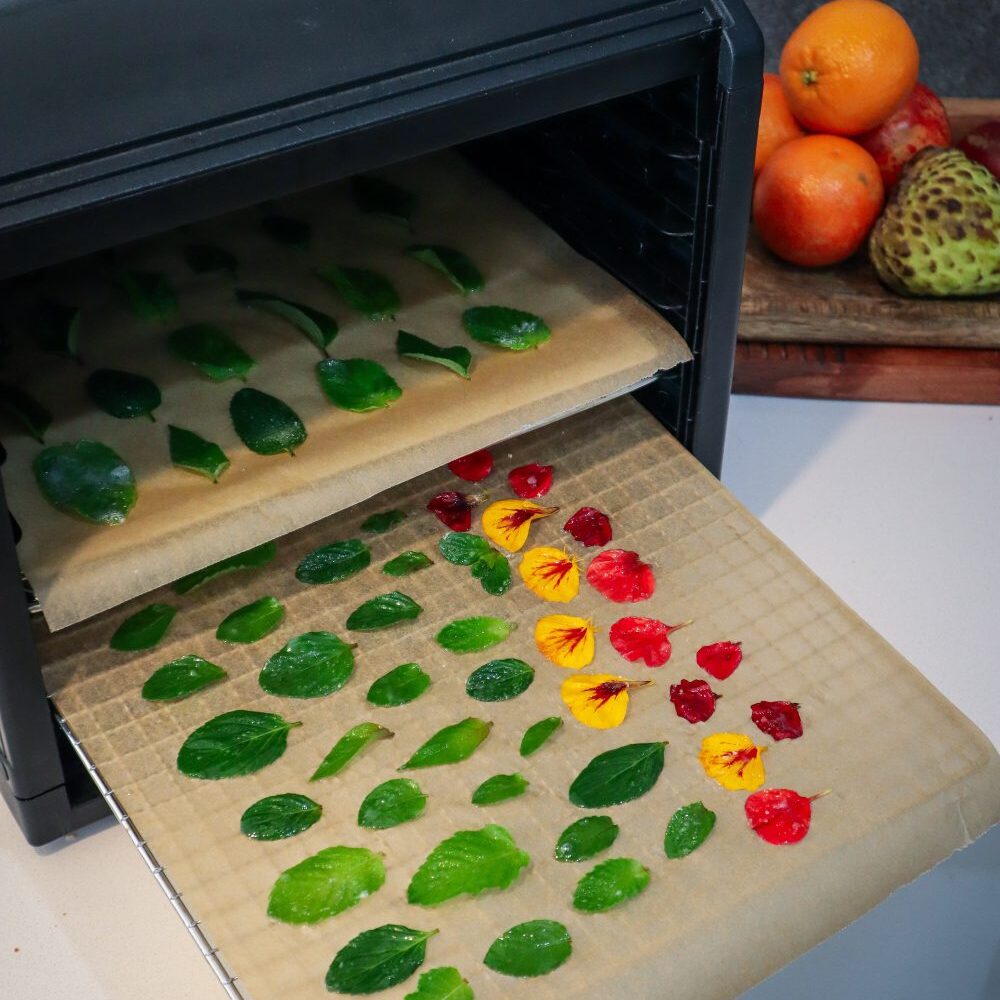
How to Make Candied Mint Leaves
All you need are a few fresh mint leaves, some egg white (or aquafaba for a vegan version), and a sprinkle of caster sugar. Simply coat each leaf in a bit of frothy egg white, dust with sugar on both sides, and let them dry for several hours until crisp. I like to leave mine on baking paper in a switched-off dehydrator or a warm, dry spot in the kitchen. They’re best made the night before and can be stored in an airtight container for a day or two.
Candied mint leaves are a great way to use up any extra mint growing in the garden, especially when it starts to take over. You can also try this method with other edible leaves like lemon balm or even tiny herb leaves for a twist.
They’re not just decorative—they’re delicious! Whether you’re topping an avocado chocolate tart, dressing up a fruit salad, or adding charm to a summer cocktail, these little leaves add a handmade, whimsical touch that’s sure to impress.
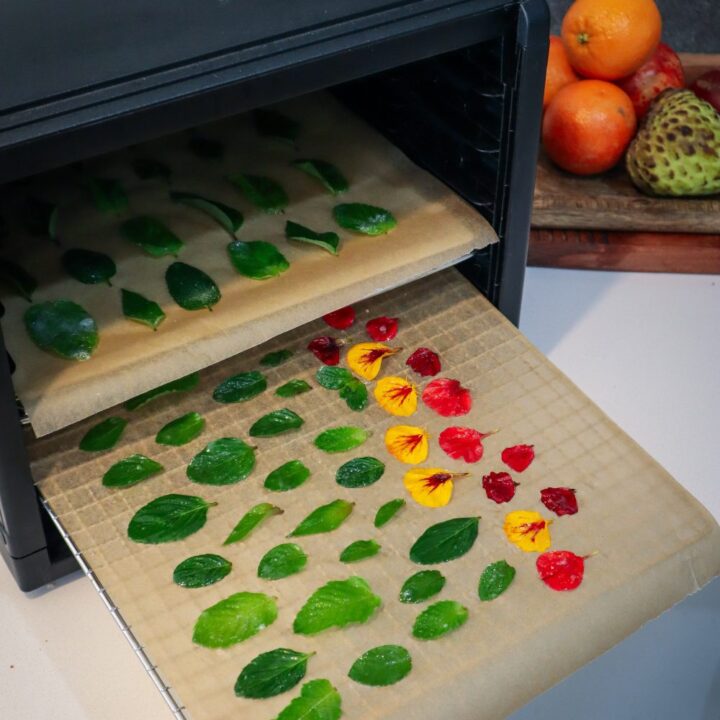
Candied Mint Leaves
Sweet and minty these candied mint leaves are a delicious addition to decorate baking or cocktails.
Ingredients
- 10 + Mint leaves*
- 1 Egg White or Aquafaba (chickpea water)
- Caster Sugar
Instructions
- Whisk egg white until frothy.
- Prepare a tray with baking paper.
- Lightly coat the mint leaves in egg white by dipping them in and wiping off excess on the edge of the bowl.
- Sprinkle both sides with sugar and place on the baking paper tray.
- Allow to rest at room temperature for 6 hours + or overnight. I stored them in my dehydrator (switched off) to keep any bugs off.
- Store in an airtight container and use within a day or two.
Notes
* Try with edible flowers or other herbs such as pineapple sage
Garden to Plate Magic
Candied mint leaves are a simple yet elegant way to elevate your homemade treats. With just a few ingredients and a bit of drying time, you can transform humble garden mint into a beautiful garnish that looks impressive and tastes delicious. Whether you’re making them for a special occasion or just to enjoy some creative time in the kitchen, they’re a fun way to celebrate what’s growing in your garden.
Happy Gardening,
Holly 🌿
Links included in this post might be affiliate links. If you purchase a product or service with the links that I provide I may receive a small commission. There is no additional charge to you! Thank you for supporting my blog so that I can continue to provide you with free content.
More Mint Posts
What Fruit Trees & Edible Plants to Avoid Planting in the Ground!
From invasive root systems to aggressive self-seeding, I will share why urban…
Avocado Chocolate Tart with Candied Mint Leaves
Rich, creamy, and dairy-free decadence straight from the garden. If you’ve ever…
Rocket, Zucchini, Pea and Mint Green Salad
Green salads are a staple in any homegrown, garden-to-plate lifestyle — but…
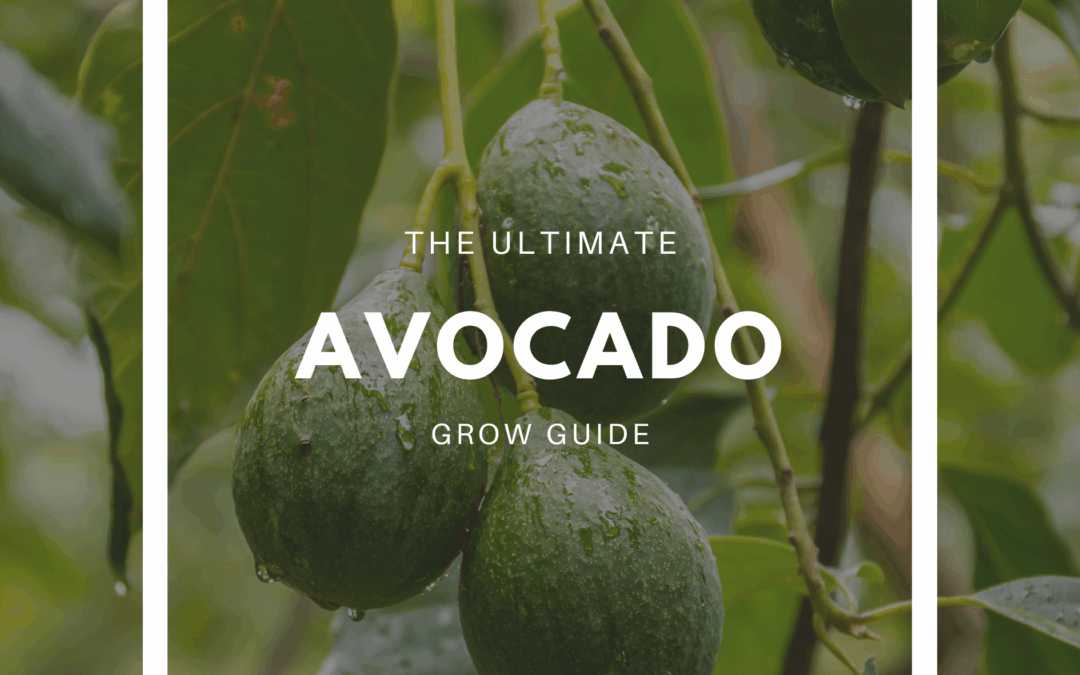
How to Grow Avocado – The Ultimate Garden-to-Plate Guide

How to Grow Avocado
Learn how to grow Avocado (Persea americana) at home and what to make with your abundant avocado crops! Avocado is a popular fruit that can be a little tricky to grow. Choosing the right variety for your climate and getting some key care points right should have you picking homegrown avocados for years to come!
Avocados can be used as evergreen shade trees or grown in pots for urban areas. Avocado trees can reach heights of 12+ meters if they are not pruned. Smaller dwarf trees will reach maximum heights of around 4 meters, but can also be pruned to keep them smaller.
Avocados are best grown from grafted trees. Growing an Avocado from seed can take anywhere from 4 to 13 years or longer to get fruit. Even then, you have no idea what the fruit will be like, as it will not be identical to the plant the seed came from. Grafted trees have mature fruiting stems grafted onto allow the tree to bear fruit within a year or two.

What parts of Avocado are edible?
Quick Tips on How to Grow Avocado at Home

Why Grow Your Own Avocado?
Here are some of the many reasons to grow Avocados.
- Evergreen shade-giving tree
- Perennial crops
- It can be expensive to buy!
- Can be used in sweet and savoury dishes
- Prolific producer
- Long harvests
- High in vitamin E and folate
- High in fibre
- Substitute for butter
Popular Avocado Varieties to Grow
Avocados come in A and B varieties. Each type flowers has male and female at different times of the day. Having both an A and a B-type Avocado will mean you will get more avocados due to an increase in pollination. Most avocados will be self-fertile, but having a second will increase the amount you get. Dwarf or semi-dwarf avocados will grow to be smaller trees, but unlike other dwarf fruit trees, they will still be up to 4m high. Keeping them pruned can maintain their size.
Type (A) Varieties
Hass – Popular small dark-skinned avocado. Most commonly found in stores due to its tough skin for transport. Small fruit, a great producer.
Reed – Large green round fruit 200-800 grams. Mild and buttery flavour. The tree tends to grow upright rather than outwards.
Choquette – Large green round fruit weighing over 1kg! Creamy, rich flesh. A cross between a Guatemalan and a West Indian type.
Semi Dwarf
Lamb Hass – Large dark-skinned avocado. Semi-dwarf tree growing 3-4 metres. Late-season fruits.
Pinkerton – Medium-sized green-skinned fruit. Semi-dwarf tree growing 3-4 metres. High oil content.
Wurtz – Medium-sized green pear-shaped fruit. Semi-dwarf tree growing 3-4 metres. Weeping branches that hang downward.
Type (B) Varieties
Shepard – Popular commercial variety. Green skin and yellow firm flesh. Smaller tree size 6-8 metres.
Bacon – Most cold-tolerant variety (may survive -5 degrees). Large pear-shaped fruit with green skin.
Fuerte – Small – medium-sized green fruit. Thin skin and buttery flesh. Produces both normal-sized and mini seedless avocados called “cukes”. Crops more biannually (every second season). Vigorous spreading tree.
Zutano – Pear-shaped fruit with green glossy skin. Low oil content and can be quite watery.
Edranol – Rough, bumpy skin with soft buttery flesh. Handles coastal environments best.
Sharwill – Medium-sized oval fruit with green skin. Rich flavour and small seeds. Frost sensitive.
Linda – Large fruit with dark purple skin. Fruits from 400-1100g each. Thick skin that is easy to peel.


TOP TIPS TO GROW AVOCADO
- Choose a sunny location
- Shelter from the wind or able to create shelter
- Prepare the soil with plenty of compost
- Free draining is key!
- Avocados hate clay soils – mound up above the ground rather than planting down in a hole
- Do not disturb roots when removing from the pot!
- Protect from the hot afternoon sun
- Keep grass and weeds away from the base
- Keep weed-free and well-mulched
When to Plant Avocados
Avocados don’t like the cold or the extreme heat, so avoid planting them in winter or summer. Choose a day when the weather will be mild for a few consecutive days.
How to Grow an Avocado
- Choose a sunny location with 6-8 hours of sunlight.
- Choose a location that can be protected from winds (shade cloth can help)
- Dig a hole and prepare the soil with compost. Mix compost and sandy soil together. For clay soils, backfill with compost and sandy soil, and create a mound above the ground.
- Carefully remove the Avocado carefully by cutting the bag or gently easing it from the pot. Try not to disturb roots when possible.
- Gently push soil against the root ball and push down with your hands to remove air pockets.
- Add a stake to help secure the tree, but do not push it through the root ball.
- Add mulch as wide as you can approx 1m but pull back from the trunk so it does not touch (this can cause collar rot)
- Add a shelter of shade cloth to the side that gets wind and afternoon hot sun.
- Paint any exposed stems with water-based white paint (nontoxic) at a ratio of about 50% paint and 50% water. This acts as sunscreen, which is important for Perth summers!
Care/ Maintenance
Avocados like plenty of food, regular top-ups with compost and mulch are important. The biggest issue with Avocados is too much water, sun or wind.
Feeding
Feed with compost or composted manure at the end of winter, before spring, and end of summer.
Watering
Deep water, especially in summer. Push your finger into the soil to the second knuckle; if it comes out dry, water well. If the soil on your finger sticks and is mois,t leave it be.
Harvesting
Avocados, like many fruit trees, should be prevented from fruiting for the first 1-3 years. Wait until the flowers sprout on long stems, then remove them. Once you start letting your Avocado fruit, it will take 1 year from when the fruit sets until it is ready to harvest. Some Avocados stay green when they are ready and ripen off the tree, so here are a few ways to tell if they are ready to pick.
- Skin turns from glossy to dull
- Stem lightens
- It’s within the varieties’ “mature fruit months” (research for your variety and area)
- Pick one and let it ripen on the bench for a week or two. If it is delicious and buttery, you can harvest more. If it shrivels and goes black, it is not ready and try again in 2-3 weeks.
- Fruit starts falling on the ground.
Pruning
The Avocado tree can grow to be a huge 10 m+ tree if left unpruned. Once your tree reaches 2m or your desired height, you can start pruning it. Be selective and try to remove branches whilst still allowing shade to the other parts of the tree. Try not to remove the bottom “skirt branches” as these protect the stem from being burnt. If once you prune the tree, there are areas of stem exposed, paint with white water-based paint (50:50 water mixed) to add protection.
Pests / Disease
Avocados mainly succumb to bacterial diseases due to excess water. Don’t water the leaves when possible and allow good drainage for the roots.
Reproducing
Seeds from the Avocados can be grown and will produce a new variety. Seed-grown Avocados can take 10+ years to actually fruit, and you never know what the fruit will be like. The best way to reproduce is to grow an Avocado from seed and then graft onto it from a tree that is already fruiting and mature. But also, if you have the room, there is no reason not to try seed-grown as you may end up with an exciting new variety.
Cooking and Using
Avocado is a powerhouse in the kitchen and can be used in a wide array of ways.
Avocado pairs well with: Tomato, onion, garlic, rocket, seafood, strawberry, nuts, lemon, potato, radish, spinach, mint, mango, kiwifruit, cucumber, corn, coconut, artichoke
Avocado ideas:
- Salads
- Toast
- Guacamole
- Chocolate moose
- Chocolate brownie
- Smoothies
- Icecream
- Pickled
Preserving the Harvest
Avocado can be frozen, just add some lemon juice to retain the colour.
More Avocado Tips and Recipes
Other Grow Guides

How to Grow Asparagus – The Ultimate Garden-to-Plate Guide
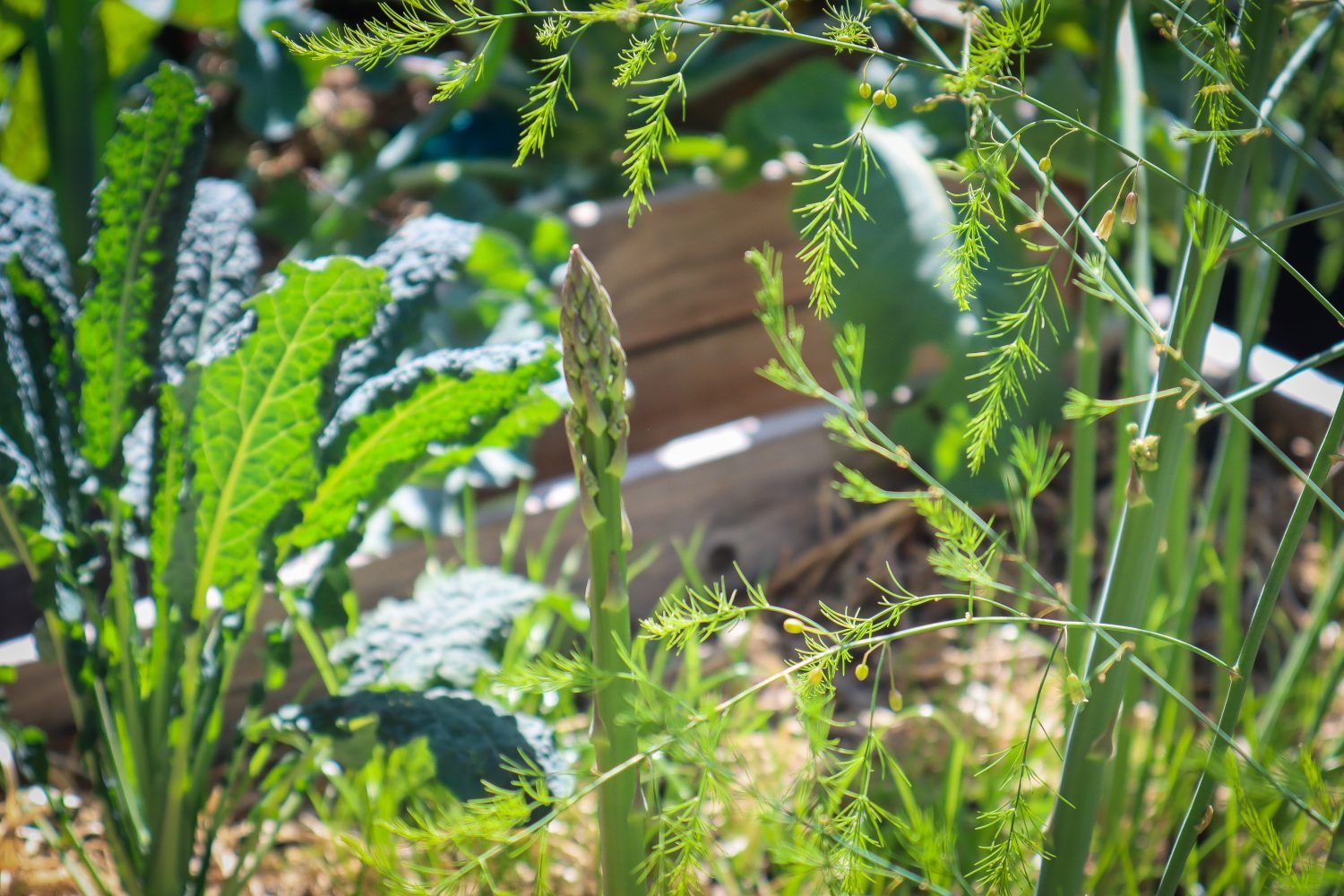
How to Grow Asparagus
Learn how to grow Asparagus and what to make with your abundant harvests. Asparagus (Asparagus officinalis) is a perennial vegetable and is a great long-term investment in your food production. Asparagus grows back each year and can produce for up to 30 years ( or longer). The great thing about Asparagus is it produces edible spears at the start of spring, which is often an “in-between” time in the garden when winter crops have finished and summer crops are not yet ready.
Asparagus does require its own spot in the garden, but it can also be grown successfully in a container garden.
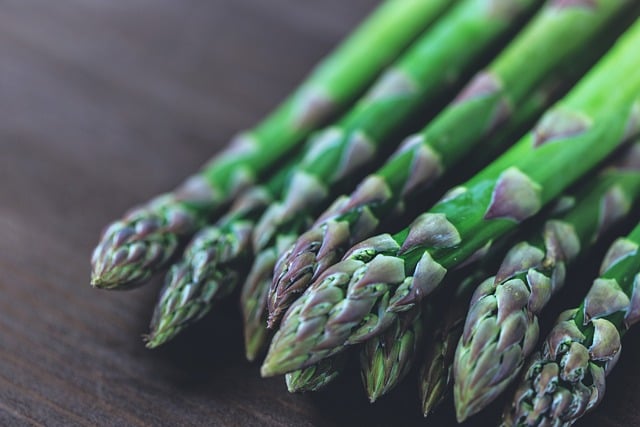
What parts of Asparagus are edible?
Quick Tips on How to Grow Asparagus at Home
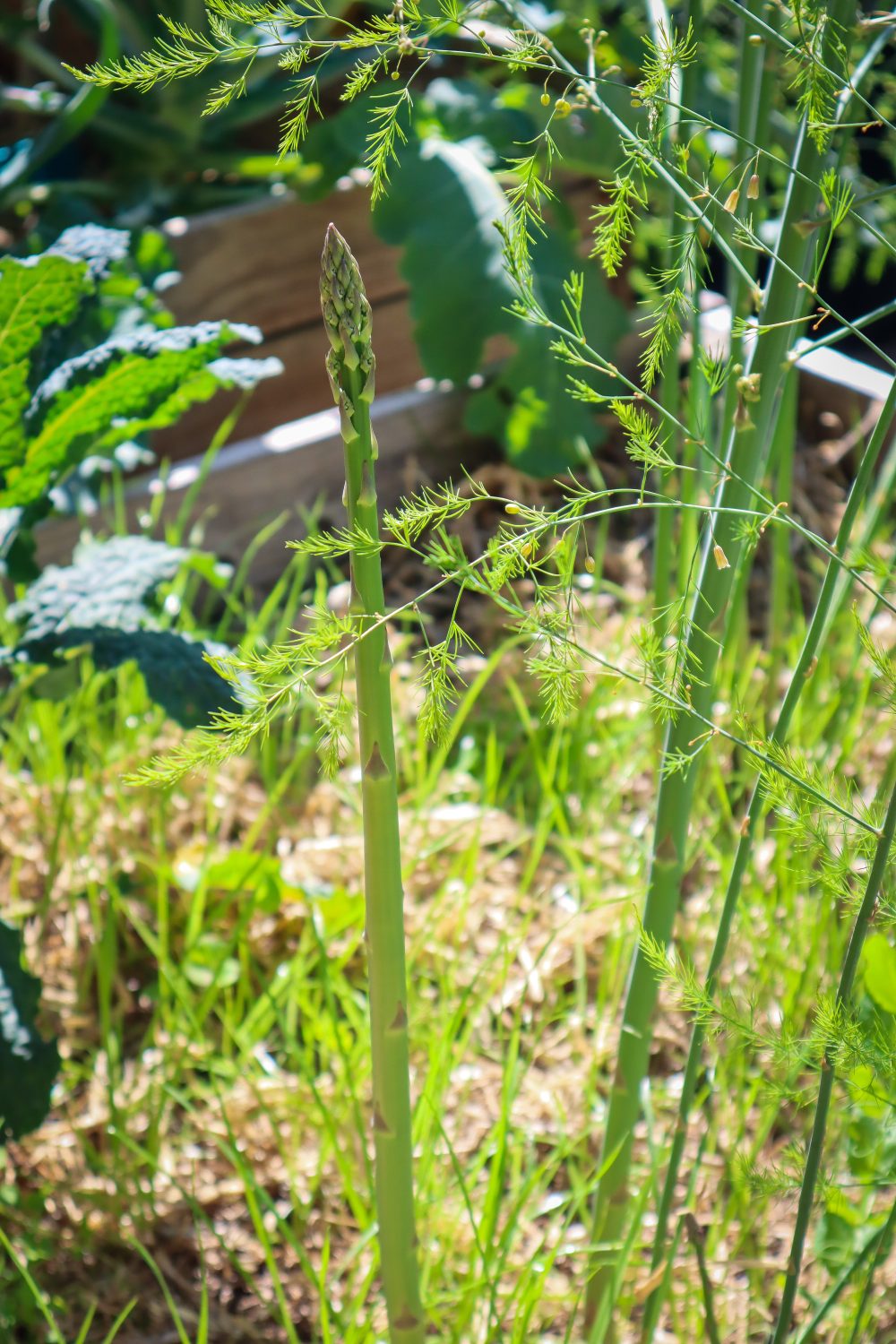
Why Grow Asparagus at Home?
Here are some of the many reasons to grow Asparagus.
- Hardy, low-maintenance vegetable
- Perennial
- Ornamental and edible
- Prolific producer
- Early Spring Harvest
- Produces up to 30 years
- High in Potassium
- Great raw or cooked
Popular Asparagus Varieties to Grow
Mary Washington – Popular open-pollinated variety. Long, tender green spears. White spears can be produced if blocked from light.
Sweet Purple – Dark purple spears with 20% more sugar than the green variety. It is also less fibrous.
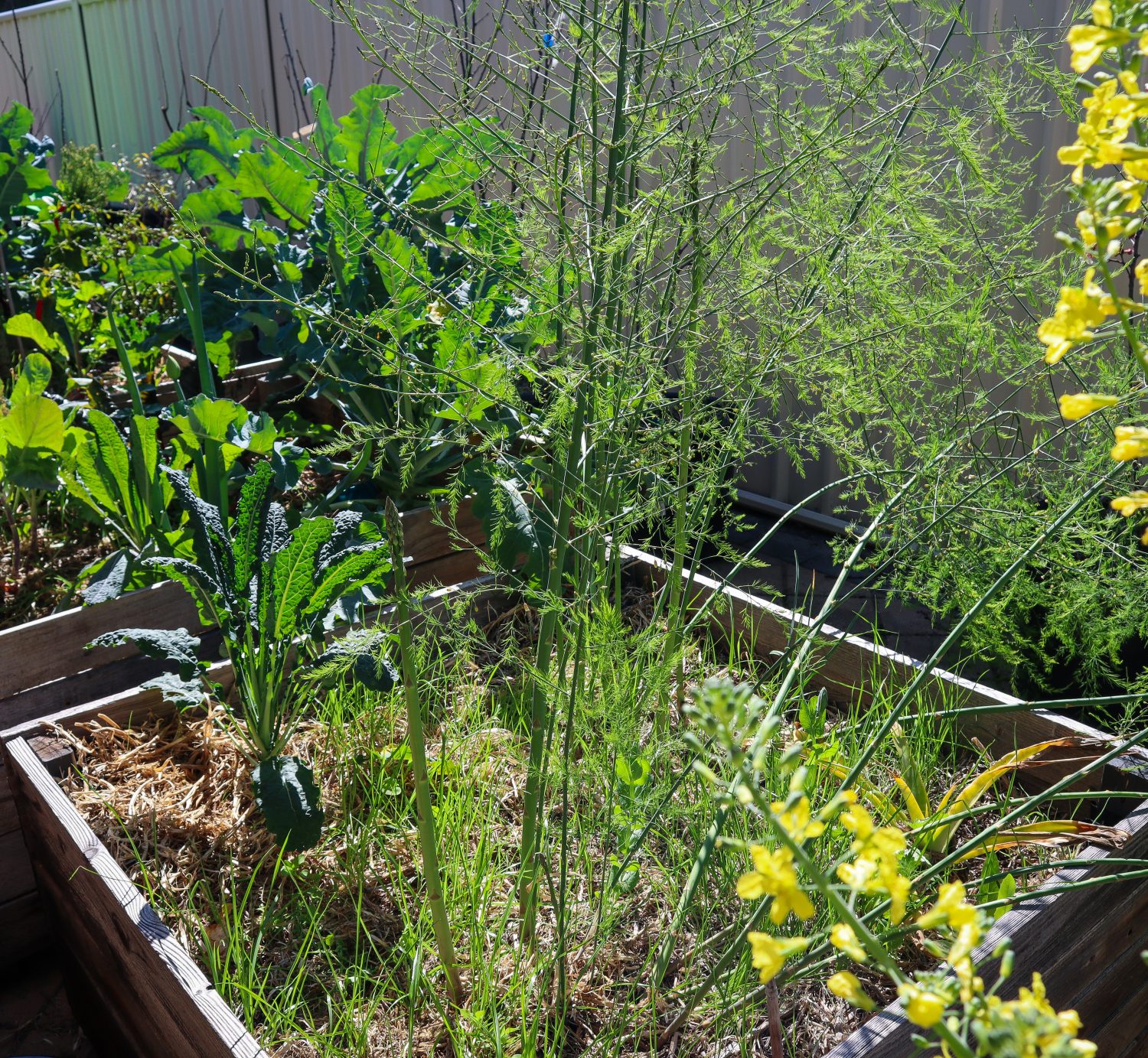
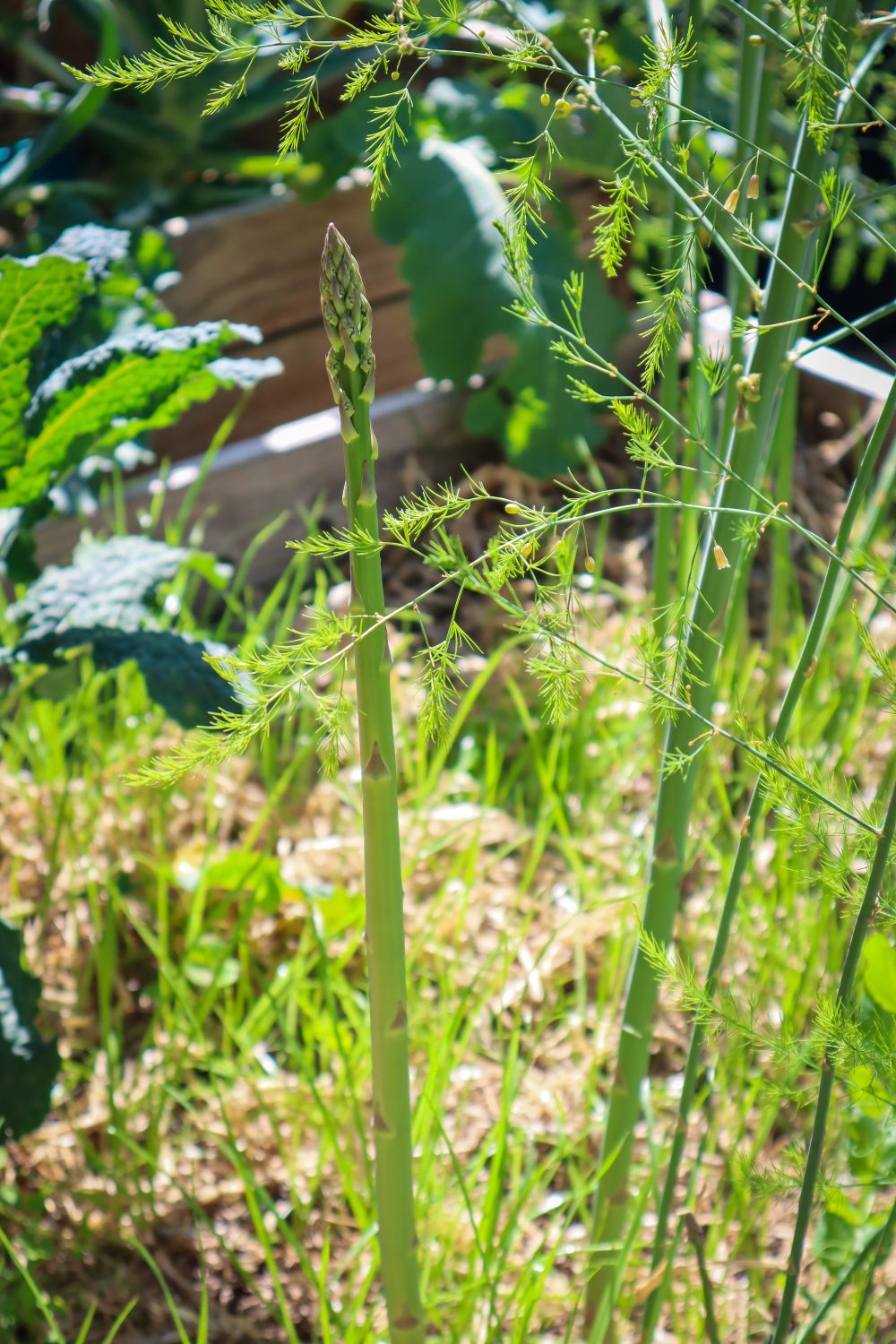
TOP TIPS ON HOW TO GROW ASPARAGUS
- Choose a sunny location that can be a permanent home
- Prepare soil with plenty of compost and well-composted manure.
- Free-draining, slightly acidic soil
- Grow from crowns for faster production
- Feed with high nitrogen or compost at the end of winter before spring growth
- Allow spears to grow into ferns for the first 2 years
- Harvest the fattest spears and leave thin ones to go to ferns
- Keep weed-free and well-mulched
When to Plant Asparagus?
If you are planting Asparagus from seed, sow seeds in Spring. Soak seeds in water for 2+ hours before planting for quicker germination. Seedlings can also be planted in spring. Established crowns should be planted while still dormant in late winter.
How to Grow Asparagus?
- Choose a sunny location with 6-8 hours of sunlight.
- Choose a location that can be a permanent home for the next 20+ years.
- Be aware of surrounding trees that may grow to overshadow the asparagus patch.
- Asparagus-like loose soil that is easy to burst through. Create mounts if you have hard or clay soils.
- Prepare beds with plenty of compost and composted manure.
- Plant 40cm apart
- Give them a deep water.

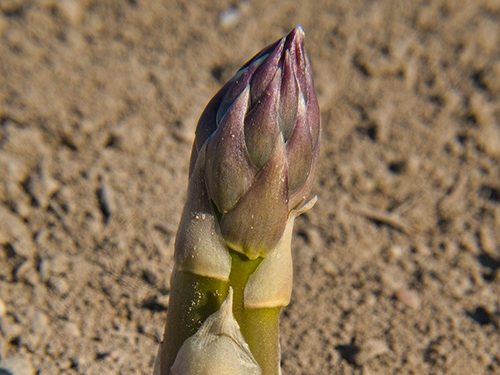
Care/ Maintenance
Asparagus comes in both male and female plants. They both produce spears, but the males are said to be of higher quality. The female plants can be identified as they produce berries at the end of the ferns. These berries can be saved and will have seeds inside that can be planted.
Feeding
Feed with compost or composted manure at the end of winter. Remulch with lupin, pea straw or sugarcane.
Watering
Deep water, especially in summer.
Harvesting
Asparagus holds its energy in the crowns, so it is important to allow the patch to establish before harvesting. From seed, Asparagus should be left for the first 2-3 years. If growing from crowns, Asparagus can be picked sparingly over the first 1-2 years. Choose the fattest spears at least pencil-width thick. Let the thin spears turn to ferns to conserve energy in the crowns for winter.
Pruning
If left, the spears will turn into tall ferns. This is how the plant conserves energy and repopulates. It’s important to allow this for the first few years. The green ferns will turn yellow and die off during mid-late winter. They can then be pruned and used as mulch or added to the compost. Once pruned, add a fresh layer of compost around the bed and re-mulch. This will keep them warm over winter and add nutrients back to the bed ahead of spring.
Pests / Disease
Aphids, slugs, snails, and slaters may like your young spears. Check plants in early spring. Natural pest management. Spears can also be affected with rust. Allow good airflow.
How/ When to Harvest
Asparagus is ready in early spring. Choose the fattest spears, bigger than pencil width and 20 – 25cm tall. Use a sharp knife and cut just below the soil line. Allow thinner spears to grow into ferns.
Reproducing
Female plants will produce berries at the end of their ferns, which contain seeds. These can be planted to expand your Asparagus patch. Crowns can be split when dormant in winter to create new patches.
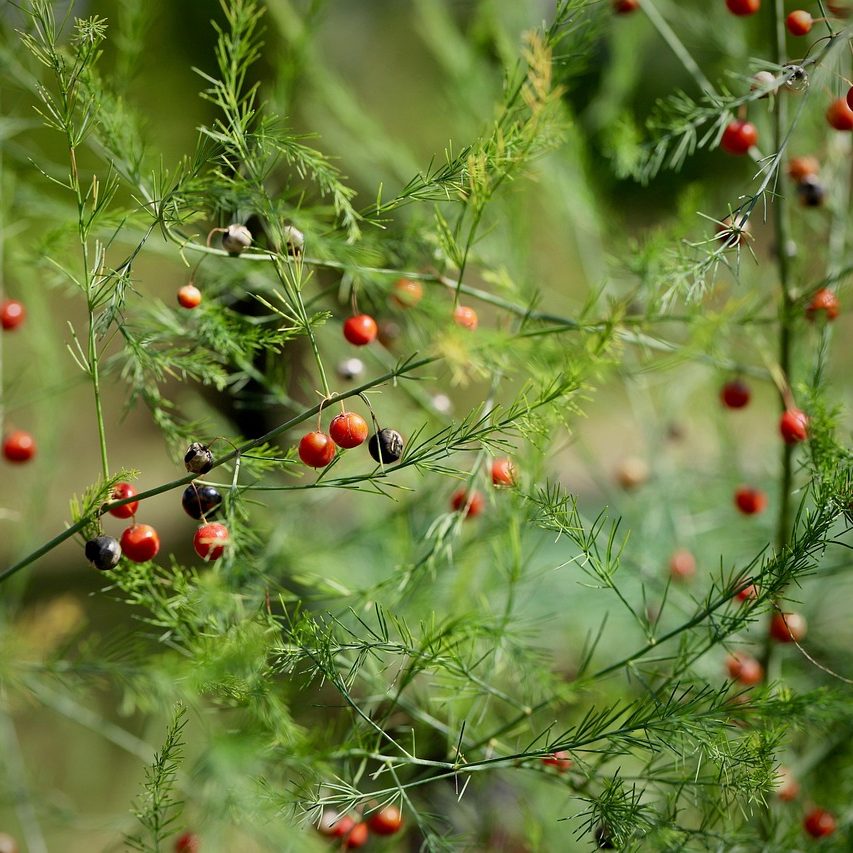
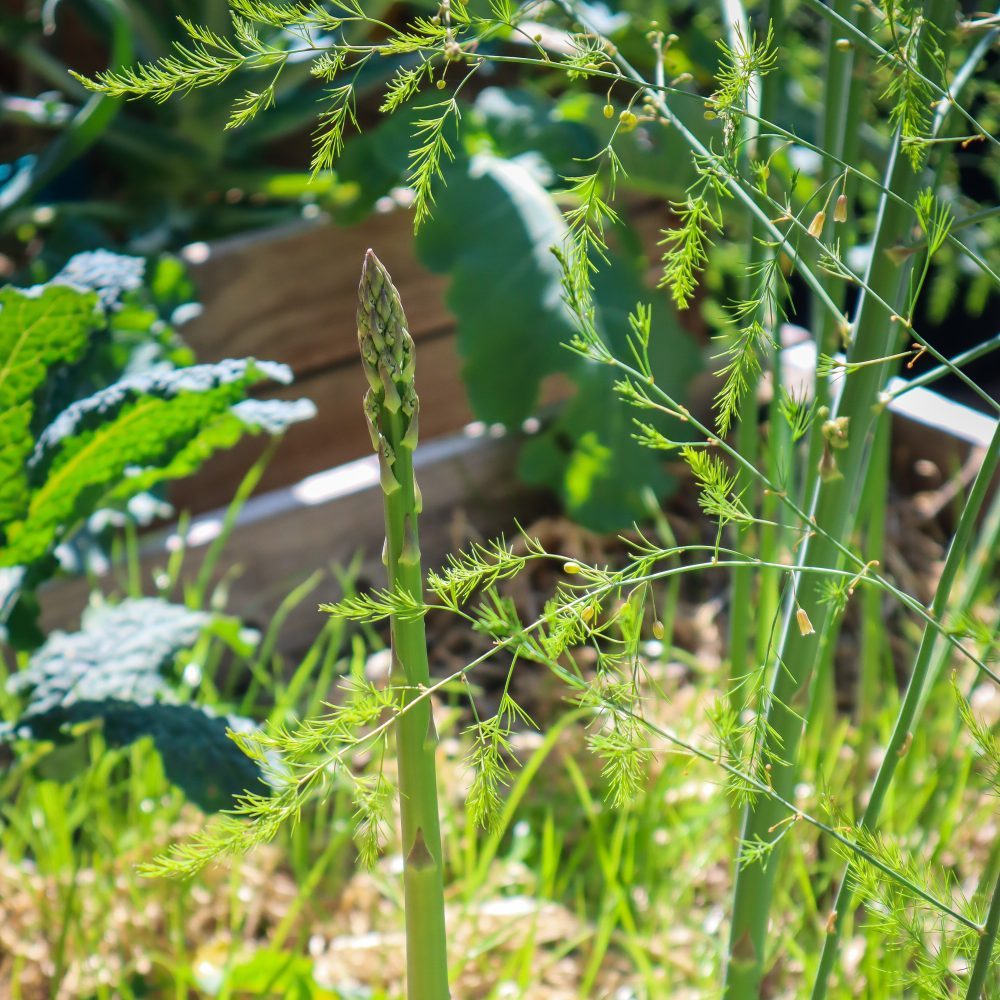
Cooking and Using
Asparagus can be eaten raw, cooked or preserved, pickled, and bottled.
Asparagus pairs well with: Mint, peas, rocket, dill, chives, cheese, eggs, cured meats, seafood, strawberry, raspberry, nuts, lemon, and potato
Asparagus ideas:
- Salads
- Pickles
- BBQ
- Quiche
- Roasted
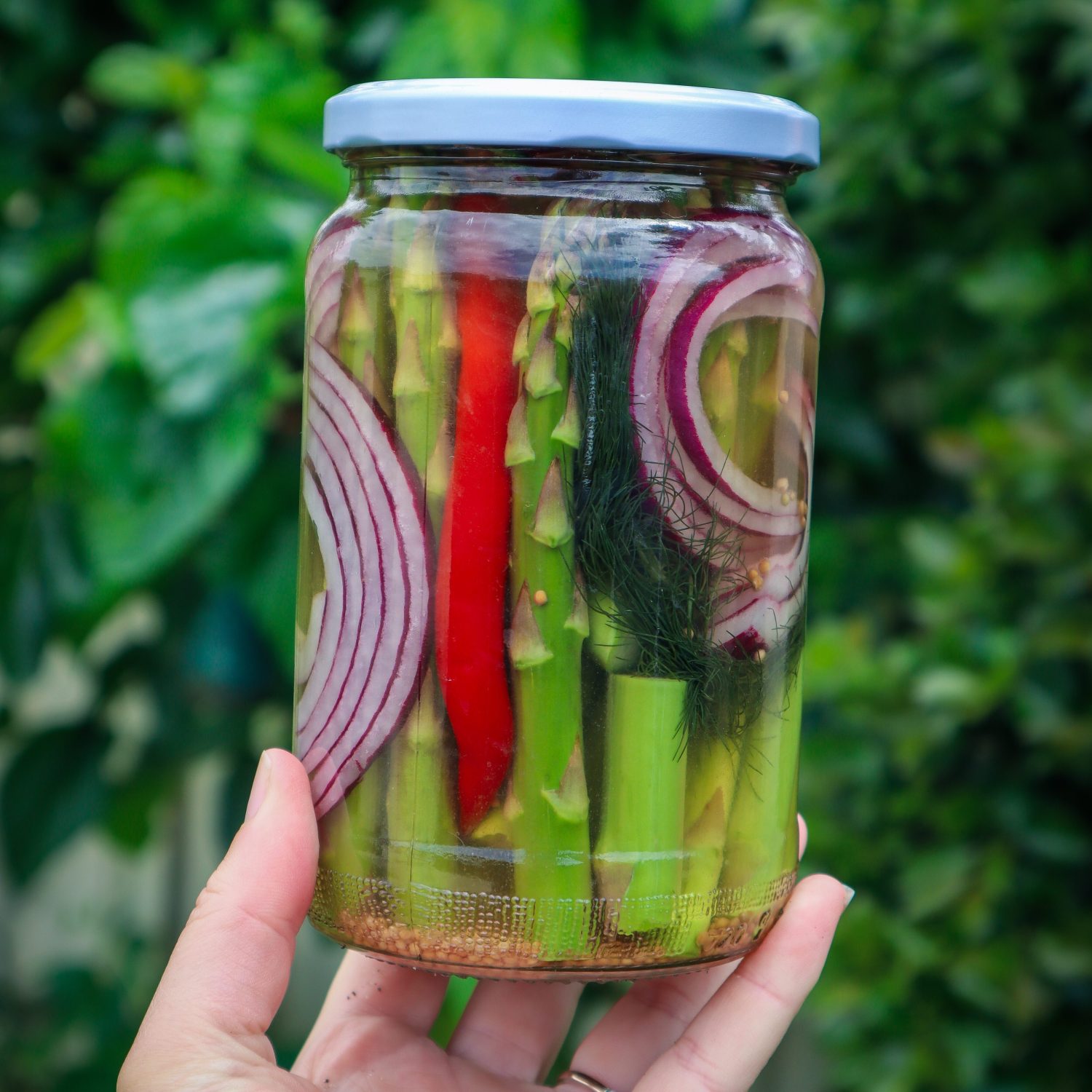
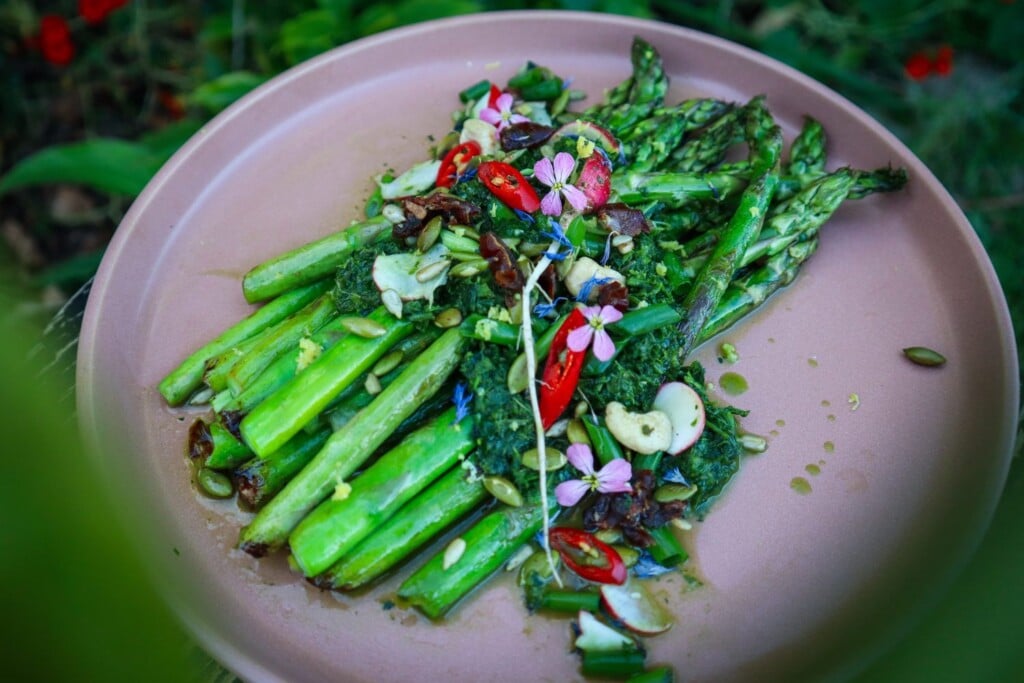
Preserving the Harvest
Asparagus can be pickled or bottled to preserve.


